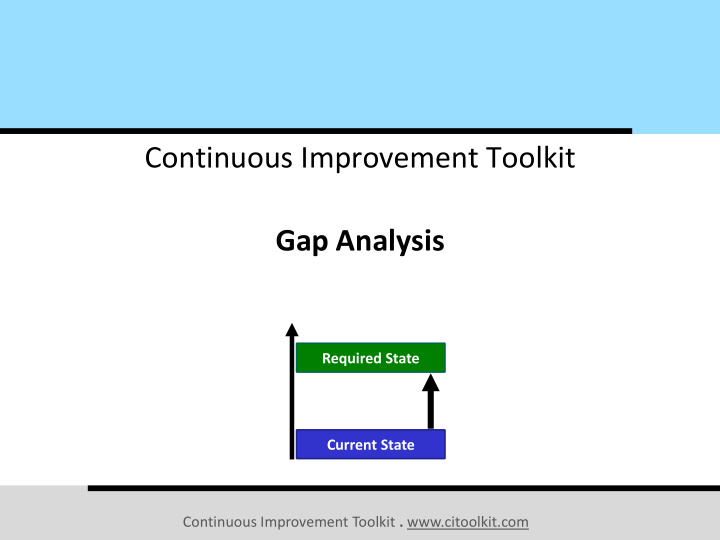



Continuous Improvement Toolkit Gap Analysis Required State Current State Continuous Improvement Toolkit . www.citoolkit.com
The Continuous Improvement Map Managing Deciding & Selecting Planning & Project Management* Risk PDPC Decision Balance Sheet Importance-Urgency Mapping Daily Planning PERT/CPM RAID Log* Force Field Analysis Cost Benefit Analysis FMEA MOST RACI Matrix Activity Networks Break-even Analysis Voting TPN Analysis Risk Assessment* SWOT Analysis Stakeholder Analysis Decision Tree Pick Chart Four Field Matrix Fault Tree Analysis Project Charter Improvement Roadmaps Critical-to Tree QFD Portfolio Matrix Traffic Light Assessment PDCA Policy Deployment Gantt Charts DMAIC Paired Comparison Matrix Diagram Kano Analysis Lean Measures Kaizen Events Control Planning Prioritization Matrix Pugh Matrix Cost of Quality* Bottleneck Analysis** A3 Thinking Standard work Document control C&E Matrix Pareto Analysis OEE KPIs Implementing Cross Training Understanding Process Yield ANOVA Chi-Square Descriptive Statistics Solutions** Cause & Effect Value Analysis Capability Indices Probability Distributions Hypothesis Testing Ergonomics Mistake Proofing Design of Experiment Gap Analysis* Multi vari Studies Histograms & Boxplots Automation Simulation TPM Confidence Intervals Reliability Analysis Graphical Analysis Scatter Plots Pull Flow Just in Time Correlation Regression Understanding MSA 5 Whys Run Charts Visual Management 5S Root Cause Analysis Performance Data Snooping Control Charts Quick Changeover Fishbone Diagram Tree Diagram* Waste Analysis Benchmarking** SIPOC* Time Value Map Sampling Morphological Analysis Process Redesign Data collection planner* How-How Diagram** Value Stream Mapping Brainstorming Spaghetti Diagram Check Sheets SCAMPER** Attribute Analysis Interviews Service Blueprints Flow Process Charts Affinity Diagram Questionnaires Relationship Mapping* Focus Groups Data Flowcharting IDEF0 Process Mapping Mind Mapping* Lateral Thinking Observations Collection Creating Ideas Designing & Analyzing Processes Suggestion systems Continuous Improvement Toolkit . www.citoolkit.com
- Gap Analysis Compares two things, what is with what should be. Often helps comparing two different states of something: • E.g.: The current state with the future state. Once the gap is identified, an action plan can be developed to bridge the gap. Continuous Improvement Required State The Gap Current State Continuous Improvement Toolkit . www.citoolkit.com
- Gap Analysis Used when comparing the actual performance of a company against the potential or desired performance. Used when working with any project management approach: • To analyze progress at any stage. • Most useful at the beginning of a project when developing the project charter. Continuous Improvement Toolkit . www.citoolkit.com
- Gap Analysis Process Improvement: Used when comparing an existing process to a process performed elsewhere. Helps to determine if the process needs to be simplified, streamlined or redesigned. • You need to compare both processes step-by-step and note the differences. • You need then to bridge the gap and reach your goals. Continuous Improvement Toolkit . www.citoolkit.com
- Gap Analysis To Conduct a Gap Analysis: Identify what you need to achieve. Understand the current situation: • Who has the knowledge that you need? • Is the information documented somewhere? • Is there is a need to conduct brainstorming sessions? • Do you need to use other data collection tools (e.g. focus groups). Identify the desired outcome: • Is there is a need to conduct benchmarking studies? Identify and document the gap. Identify how to bridge the gap. Continuous Improvement Toolkit . www.citoolkit.com
- Gap Analysis Performance Indicators: Gap analysis is conducted to address the unsatisfactory performance of a process. It is common to use performance indicators to compare the current performance against targeted performance. You may use these indicators at any point in the project life cycle. Continuous Improvement Toolkit . www.citoolkit.com
- Gap Analysis Example – The Food Takes Too Long to be Served Identify objectives Current situation Desired outcome The gap 1- Reduce food 1- The food takes on 1- The food should 1- Three minutes. be served within 11 preparation time average 14 minutes without affecting to be served. minutes of ordering. quality. Actions / requirements • • • Continuous Improvement Toolkit . www.citoolkit.com
Recommend
More recommend